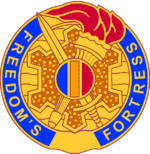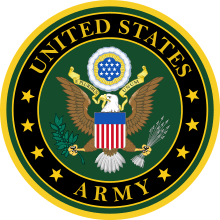United States Army Training and Doctrine Command
Established 1 July 1973, the United States Army Training and Doctrine Command (TRADOC) is a major command of the United States Army headquartered at Fort Eustis, Virginia. It is charged with overseeing training of Army forces and the development of operational doctrine. TRADOC operates 37 schools and centers at 27 different locations. TRADOC schools conduct 1,304 courses and 108 language courses. The 1,304 courses include 516,000 seats (resident, on-site and distributed learning) for 443,231 soldiers; 36,145 other-service personnel; 8,314 international soldiers; and 28,310 civilians.
| Training and Doctrine Command | |
|---|---|
 Shoulder sleeve insignia | |
| Active | 1973–present |
| Branch | |
| Type | Army Command |
| Role | Recruit, train, and educate U.S. Army Soldiers[1] |
| Garrison/HQ | Fort Eustis |
| Website | www |
| Commanders | |
| Current commander | GEN Paul E. Funk II |
| Command Sergeant Major | CSM Timothy A. Guden |
| Deputy Commanding General/Chief of Staff | LTG Theodore D. Martin |
| Insignia | |
| Distinctive unit insignia |  |
The current commanding general of TRADOC summarizes its function as an organization to design, develop, and build[2] the Army.[3] Thus, three major commands of the Army (TRADOC, FORSCOM, and AMC) shape its present "men and materiel".[3][4]
Mission
The official mission statement for TRADOC states:
U.S. Army Training and Doctrine Command develops, educates and trains Soldiers, civilians, and leaders; supports unit training; and builds and integrates a versatile mix of capabilities, formations, and equipment to strengthen the U.S. Army as America's Force of Decisive Action.[5]
History
TRADOC was established as a major U.S. Army command on 1 July 1973. The new command, along with the U.S. Army Forces Command (FORSCOM), was created from the Continental Army Command (CONARC) located at Fort Monroe, Virginia. That action was the major innovation in the Army's post-Vietnam reorganization, in the face of realization that CONARC's obligations and span of control were too broad for efficient focus. The new organization functionally realigned the major Army commands in the continental United States. CONARC, and Headquarters, U.S. Army Combat Developments Command (CDC), situated at Fort Belvoir, Virginia, were discontinued, with TRADOC and FORSCOM at Fort Belvoir assuming the realigned missions. TRADOC assumed the combat developments mission from CDC, took over the individual training mission formerly the responsibility of CONARC, and assumed command from CONARC of the major Army installations in the United States housing Army training center and Army branch schools. FORSCOM assumed CONARC's operational responsibility for the command and readiness of all divisions and corps in the continental U.S. and for the installations where they were based.
Joined under TRADOC, the major Army missions of individual training and combat developments each had its own lineage. The individual training responsibility had belonged, during World War II, to Headquarters Army Ground Forces (AGF). In 1946 numbered army areas were established in the U.S. under AGF command. At that time, the AGF moved from Washington, D.C. to Fort Monroe. In March 1948, the AGF was replaced at Fort Monroe with the new Office, Chief of Army Field Forces (OCAFF). OCAFF, however, did not command the training establishment. That function was exercised by Headquarters, Department of the Army through the numbered armies to the corps, division, and Army Training Centers. In February 1955, HQ Continental Army Command (CONARC) replaced OCAFF, assuming its missions as well as the training missions from DA. In January, HQ CONARC was redesignated U.S. Continental Army Command. Combat developments emerged as a formal Army mission in the early 1950s, and OCAFF assumed that role in 1952. In 1955, CONARC assumed the mission. In 1962, HQ U.S. Army Combat Development Command (CDC) was established to bring the combat developments function under one major Army command.[6]
Sub-organizations
Core Function Leads
- Combined Arms Center (USACAC)
- U.S. Army Cadet Command
- United States Army Recruiting Command
- Center for Initial Military Training
- Basic Combat Training
- Fort Benning
- Fort Jackson
- Fort Leonard Wood
- Fort Sill
- Basic Combat Training
- Officer Candidate School
- United States Army Center of Military History, excepting the Institute of Heraldry, which remains within the Office of the Administrative Assistant to the Secretary of the Army
Centers of Excellence
- Aviation Center of Excellence (USAACE)
- Cyber Center of Excellence (CyberCoE)
- Cyber School
- Signal School
- Fires Center of Excellence (FCoE)
- Intelligence Center of Excellence (USAICoE)
- Maneuver Center of Excellence (MCoE)
- Maneuver Support Center of Excellence (MSCoE)
- Engineer School
- Chemical, Biological, Radiological, Nuclear (CBRN) School
- Military Police School
- Medical Department Center and School (MEDCoE)
- Mission Command Center of Excellence (MCCoE)
- NCO Leadership Center of Excellence (NCOLCoE)
- Sustainment Center of Excellence (Combined Arms Support Command)
- Adjutant General School
- Army Logistics University
- Logistics Leader College
- College of Professional and Continuing Education
- Army Sustainment (professional publication)
- NCO Academy
- Transportation
- Ordnance
- Quartermaster
- Financial Management School
- Ordnance School
- Quartermaster School
- Soldier Support Institute
- Transportation School
Former
- United States Army Capabilities Integration Center
- Brigade Modernization Command
Commanders
The current Commanding General is GEN Paul E. Funk II.[7] The Command Sergeant Major is currently CSM Timothy A. Guden.[8]
See also
- TRADOC Command Overview video on YouTube
- John F. Kennedy Special Warfare Center and School
- Human dimension
Comparable organizations
References
- "U.S. Army Training and Doctrine Command (TRADOC) -- Victory Starts Here!". www.tradoc.army.mil. Retrieved 2 April 2018.
- usnavalwarcollege (2 November 2015). "Lecture of Opportunity - Gen. David G. Perkins: The Army Operating Concept". Retrieved 2 April 2018 – via YouTube.
- David G. Perkins, TRADOC Priorities
- US Army TRADOC (17 March 2016). "Perkins reviews AOC, Big 8 from TRADOC's perspective". Retrieved 2 April 2018 – via YouTube.
- http://www.tradoc.army.mil/FrontPageContent/Docs/Command%20Brief_SEPT12.pdf
- TRADOC Military History - FAQs. Tradoc.army.mil. Retrieved on 2013-07-23.
- Townsend takes command of TRADOC
- TRADOC CSM
